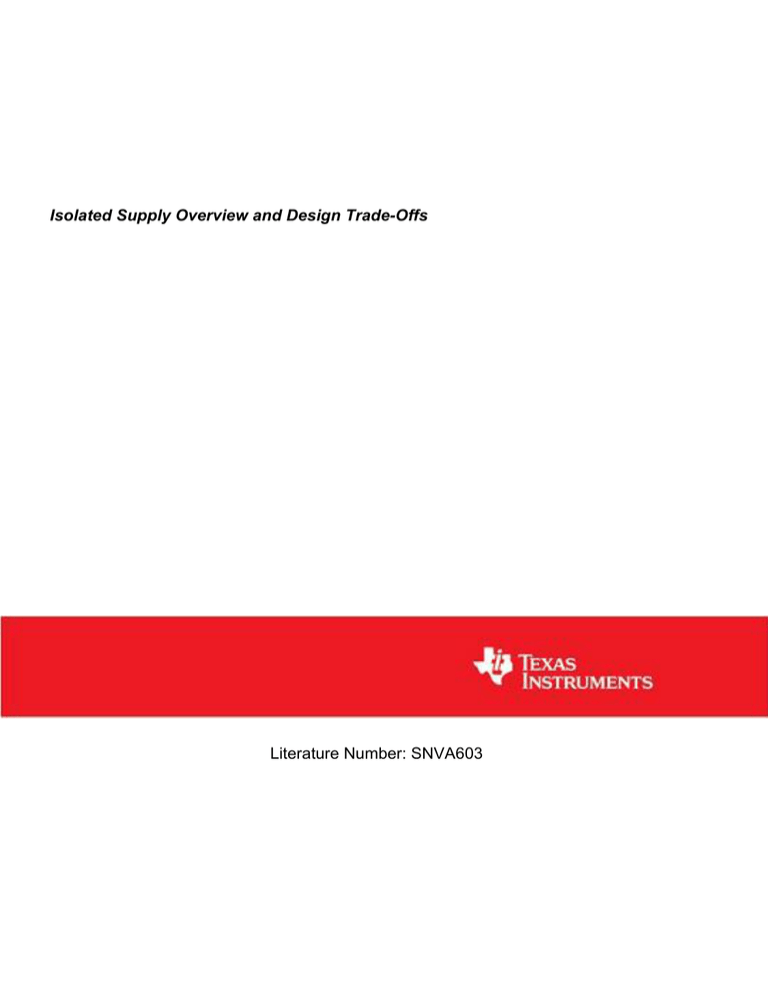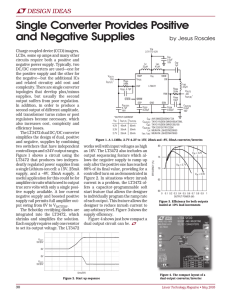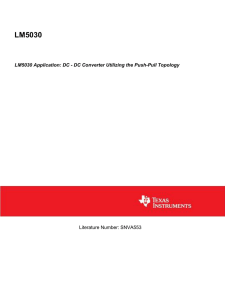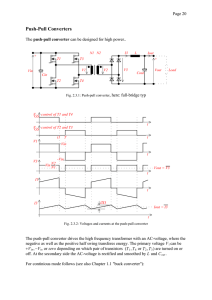
Isolated Supply Overview and Design Trade-Offs
Literature Number: SNVA603
POWER designer
Expert tips, tricks, and techniques for powerful designs
No. 119
124
Isolated Supply Overview and Design Trade-Offs
Feature Article ............... 1-9
— By David Baba, Product Applications Engineer
Comms Applications ........2
Introduction
The design of the power architecture within the communications infrastructure market consists of many trade-offs and design considerations. Multiple
factors such as input and output voltage, output current, space constraints,
efficiency, as well as the priority the designer places on each of these needs,
determine which topology should be used. This article addresses design
considerations from a topology selection perspective, providing an overview
of each topology's operation and the solution that is best implemented given
the system’s needs and the trade-offs involved.
Basic topology descriptions are provided along with waveforms. Equations
are also provided which are useful for determining RMS ripple currents and
losses in the pass elements. Note: The equations have been derived using small
ripple approximation; namely, all current slopes are approximated to zero.
Isolated Supply Overview
Isolation is required primarily for safety. Isolated circuits are protected from
potentially lethal transient voltages and currents present on the primary side
of isolation. Isolation also removes ground loops that would otherwise be
present in a non-isolated design. The removal of ground loops increases noise
immunity of the secondary supply.
There are also proven benefits to isolation, such as the freedom to step down
voltages from the primary to the secondary side. Isolation also makes it
possible to create a negative supply from the primary to secondary side of the
isolation transformer. Conversely, it is possible to generate a positive supply
from a negative supply.
Flyback Converter Continuous Conduction Mode (CCM)
Single-Ended Topology
Operation of a Flyback Converter
The flyback converter is a buck-boost derived topology. This means that the
transfer function is of the form VOUT/VIN= D/(1-D) where D is a fraction
of the switching period during which the main switch is on. What appears
to be a transformer is actually a coupled inductor or “flyback transformer”
High Efficiency. Low Power.
Energy-Efficient Solutions for Communications Infrastructure
National’s communications infrastructure solutions and subsystems are designed to meet
the needs of wired data center, wireless base station, and merchant power systems.
© 2009, National Semiconductor Corporation. National Semiconductor, , and PowerWise are registered trademarks. All rights reserved.
Maximize infrastructure bandwidth and energy
efficiency using National’s PowerWise® solutions.
national.com/comms
Wired and Data Center
Applications
PowerWise® Adaptive
Voltage Scaling (AVS),
a closed-loop voltage
optimization technology,
reduces both active and
standby energy consumption
in digital subsystems.
Wireless Base Station
Applications
National’s high dynamic
range receiver subsystems
enable multi-carrier and
multi-standard radios.
Merchant and Point of Load
Power Solutions
National’s end-to-end power
management solutions
maximize power density and
thermal dissipation.
POWER designer
Isolated Supply Overview and Design Trade-Offs
T1
N:1
VIN
acceptable up to an output level no greater than
150W. Above this power level, other topologies
more suitable for greater power levels should
be considered. In comparison to all of the other
isolated topologies, the flyback topology uses the
least components and therefore typically has the
smallest footprint, particularly at low power levels.
The flyback converter uses a single FET to energize
the transformer, utilizes a single-output diode, and
does not need an output inductor. As a result, the
current to the output is discontinuous and the output voltage ripple will be greater.
D1
CIN
VOUT
COUT
Q1
Gate
Q1
Figure 1. A Flyback Converter
since the current does not flow simultaneously in the primary and secondary. As in
a traditional buck-boost topology, the
output is inverted. For a positive voltage
on the output, the dots are reversed as
shown in Figure 1. When Q1 is turned
on, then VIN is applied across the primary
of the transformer, and energy is stored in
the primary winding. When Q1 turns off,
this stored energy is transferred to the secondary and D1 conducts supplying energy
to the load. The voltage and currents are
scaled according to the turns ratio.
It should be noted that the currents in
the output and input are both pulsating,
and therefore the ripple current ratings
for the input and output capacitors are
relatively high. Additional capacitors may
be needed to handle this rating in higherpower designs.
Ideal Use of a Flyback Converter
A flyback topology is typically the firstchoice topology for an isolated power
supply when a simple low-cost solution is
required. Flyback topologies are also very
useful for generating multiple voltages.
Only a single output is typically regulated,
but it is straightforward to add windings
to the transformer for additional voltage
rails. A flyback converter is generally
SET D = 0.5
For VIN NOMINAL
V
TOFF = (1 - D) x TS
TS
VGATE
IpT1
TON = D x TS
N=
TON
n ≈ 0.85
D x VIN
(1-D) x VOUT
Time
TOFF
IpriPK = IINAVE +
IpkP
IINAVE =
ID1
IOUT
N
VOUT x IOUT
VIN x n
Time
I secPK =
IOUT
IOUT
(1-D)
Time
VDS
VDS = VIN + (VOUT x N)
Time
VD1
Time
COUTRMS
OA
CINRMS
OA
VRRM =
ICOUTRMS = IOUT x
VIN
+ VOUT
N
D
(1-D)
Time
(1-D)
ICINRMS = IINAVE x
D
Time
xxFigure 2. Flyback Converter Waveforms
national.com/power
3
POWER designer
Isolated Supply Overview and Design Trade-Offs
The transformer is automatically reset by
the output voltage during the off period and
therefore does not require a reset winding.
Forward Converter,
Single-Ended Topology
Operation of a Forward Converter
The forward converter is a buck-derived
topology and, as such, it has a non-pulsating output current due to the usage of an
output inductor. This topology uses a reset
winding (Nr) on the transformer to reset
it. When Q1 is turned on, D1 is forward
biased, the voltage across the secondary
is equal to VIN/N, and D2 and D3 are
reverse biased. VIN is applied to the primary
winding and the magnetizing current
increases at a rate of VIN/LM, where LM is
the magnetizing inductance.
NR
During the (1-D) period, Q1 is turned off but
the magnetizing current must continue to
flow, causing the voltage across Np to reverse.
The current commutates through D3, decreasing the magnetizing current in Np
and resetting it to zero. During this period,
D1 is reverse biased and the output current
then flows through D2. D2, as in a buck
converter, acts as a free-wheeling diode.
Ideal Use of a Forward Converter
The forward converter is relatively simple
compared to the bridge topologies, making
it a popular choice for isolated supplies up
to 200W of output power. Like the flyback
converter, it uses a single FET to magnetize
the primary of the transformer. However,
because a forward is buck derived, the output inductor ensures continuous current
flow to the output capacitor, which reduces
the RMS ripple currents in it.
4
LOUT
D1
VOUT
NP
D2
CIN
COUT
D3
Q1
Gate
Q1
Figure 3. A Forward Converter
SET D = 0.5
V
For VIN NOMINAL
TOFF = (1 - D) x TS
TON = D x TS
VIN x D
=N
VOUT
TS
VGATE
Time
IpT1
The maximum duty cycle is set to less than
50% if Np = Nr. The transformer is reset
during the Q1 off interval (1-D).
T1
N:1
VIN
TON
TOFF
IRMS pri ≈ Ipk pri Dmax
IIN
Ipk pri = ave
D
V xI
IIN ave = OUT OUT
VIN x H
Time
Ipkp
IOUT
x D x (1-D)
N
ICINRMS ≈
ICINRMS
Time
VDS
VDSpk = NP x VIN +VIN
N,
(
IDISEC
)
Time
IOUT
ID 1
AVE
ID2SEC
ID 2
AVE
VSEC
= IOUT x D
Time
IOUT
= IOUT x (1-D)
Time
VIN
N
Time
VIN
N
ILOUT
ILOUT
PP
=
(VOUT) x (1 - Dmax)
Time
Figure 4. Forward Converter Waveforms
LOUT x FS
POWER designer
Isolated Supply Overview and Design Trade-Offs
Active-Clamp Forward Converter
Operation of an Active-Clamp Forward Converter
During the on (D) period, VIN is applied to the
primary of the transformer. The voltage on the
secondary is VIN/N and the magnetizing current
increases at a rate of VIN/LM.
It is important to note that synchronous FETs
replace the diodes in the forward configuration.
This highlights one advantage of the active clamp
forward; namely, it lends itself well to self-driven
synchronous rectification. Unlike a typical forward,
the active clamp drives the sync FETs over the complete switching period, yielding greater efficiencies.
During the (1-D) interval, Q1 turns off and Q2
turns on. The magnetizing current continues to
flow in the same direction, but now it flows through
Q2. Due to the volt-second balance of the transformer, VIN/(1-D) is seen across the C-clamp
capacitor (also referred to as the reset voltage). The
voltage across the primary and the magnetizing
inductance is now reversed and the magnetizing
current in the primary now ramps down to a negative value since VIN/(1-D) is larger than VIN. Due to
the volt-second balance of the flux, this completely
resets the magnetizing current to where it was at the
start of the switching period.
As a cautionary note, the benefits of synchronous
rectification diminishes as the VOUT increases beyond
12V due to switching losses, thereby increasing
total FET losses.
T1
N:1
VIN
LOUT
VOUT
Q4
CIN
Q1
Cclamp
Q1
Gate
COUT
Q3
Q2
Q2
Gate
D3
Figure 5. An Active-Clamp Forward Converter
SET D = 0.5
V
For VIN NOMINAL
TON = D x TS
TS
VGATE Q1
D=
TON
VSEC
TOFF = (1 - D) x TS
VOUT x N
VIN
Time
TOFF
VSEC =
VOUT
ICIN
OA
CIN
≈ IINave
RMS
(1-D)
x
D
VIN
N
VSEC =
VCL - VIN
N
IINAVE x (1-D)
D
Time
– IINAVE
Figure 6. Active-Clamp Forward Converter Waveforms
national.com/power
5
POWER designer
Isolated Supply Overview and Design Trade-Offs
SET D = 0.5
V
For VIN NOMINAL
TON = D x TS
TS
D=
VGATE Q1
V
TON
TOFF = (1 - D) x TS
VOUT x N
VIN
Time
TOFF
OV
Time
-VGATE Q2
VIN
(1-D)
VQ1pk
ICclamp PKPK =
ICclamp
VIN x D
LPRI x Fs
Push-Pull Converter
Operation of a Push-Pull Converter
The push-pull converter is essentially an interleaved forward converter whose primary
winding is made up of a center-tapped transformer. The push-pull converter is prone to
flux imbalance problems and therefore current-mode control, rather than voltage-mode
control, is recommended. The transformer for
a given output power is smaller than that of
a forward converter since the core is utilized
in Quadrant 1 and 3 of the BH-loop curve.
PKPK
Q1 conducts during the D period followed
by Q2 conducting for an identical length
D
VOUT x IOUT
of time during another D period, attaining
IINave =
VIN x H
volt-second balance on the primary winding.
Time
During the 1-D period, both FETs are off.
IsQ3RMS = IOUT x √D
IsQ3
The 1-D period follows each of the respective
IOUT
IINAVE x N
D periods. During the two D periods, VIN is
seen from the center tap to the drain of its
IsQ4RMS ≈ IOUT x 1-D
IsQ4
respective FET. The non-conducting winding
IOUT
will see a reversal in voltage to maintain voltILOUT
second balancing, yielding twice the input
voltage across the total primary-side winding
VOUT x (1-D)
ILOUTPKPK =
LOUT x Fs
and as seen by the drain of the non-conducting FET. The same voltage is seen on each half
Time
of the secondary, during each D period scaled by a factor of N. The diodes provide
Figure 7. Active-Clamp Forward xxxxxx
rectification of each of the two D periods,
Converter Waveforms (Continued) xxxxxx
producing a 2 x FSW pulsating voltage waveIdeal Use of an Active-Clamp Forward Converter
form at the left side of LOUT, from 0V to VIN
The addition of the active clamp to the forward
x D/N. The diode D1 conducts during the same D
converter allows the realization of greater efficiencies
period that Q2 conducts. The diode D2 conducts
through the use of synchronous FETs, the eliminaduring the same D period that Q1 conducts. It
tion of switching losses in the primary FET due to
should be noted that during the two 1-D periods,
zero voltage switching (ZVS), and the non-dissipative
neither Q1 nor Q2 is on, and diodes D1 and D2
reset of the transformer recycling the leakage inducboth conduct to maintain current flowing into
tive energy back to the input. Another benefit is
LOUT. As is the case with the buck converter during
lower EMI due to soft switching which makes this
the (1-D) period, D1 and D2 conduct simultanetopology an ideal choice for low-noise applications.
ously and act as the free-wheeling pass element.
IpT1
IpRMS ≈ IpT1center x √D
6
IpT1 center =
IIN ave
POWER designer
Isolated Supply Overview and Design Trade-Offs
SET D = 0.5
V
VIN
For VIN NOMINAL
TS
D=
VGATE Q1
T1
N:1
CIN
LOUT
D1
TOFF = (1 - D) x TS
TON = D x TS
VOUT x N
2 x VIN
VOUT
V
COUT
D2
Ton
Time
VGATE Q2
Time
Q4
Q1
Gate
Q1
Q2
VSEC =
VSEC
Q2
Gate
VIN
N
Time
VIN
N
(1 - 2D)
CINRMS ≈ IINAVE x
2D
Time
VSEC =
ICIN
0A
Figure 8. A Push-Pull Converter
Figure 9. Push-Pull Converter Waveforms
SET D = 0.5
V
For VIN NOMINAL
VGATE Q1
V
TOFF = (1 - D) x TS
TON = D x TS
TS
D=
TON
VOUT x N
2 x VIN
Time
VGATE Q2
Time
VQ1pk
IpQ1
2 x VIN
IQ1RMS ≈ IpT1center x D
IpQ2
IsD1
Ip T1center =
IINAVE
2D
Time
IsD1RMS = IOUT x D
IOUT
IOUT
2
IsD2RMS ≈ IOUT x D
IsD2
IOUT
IOUT
2
ILOUTPKPK =
ILOUT
VOUT x ( 1 - 2D)
VOUT x FS
IOUT
Time
Figure 10. Push-Pull Converter Waveforms
national.com/power
7
POWER designer
Isolated Supply Overview and Design Trade-Offs
Ideal Use of a Push-Pull Converter
A push-pull converter operates as an interleaved forward converter and is ideal for higherpower designs above 200W. The push-pull
converter has all the benefits of a forward
converter while exhibiting lower input and
output ripple currents compared to the forward, thus having smaller filter components.
The push-pull converter can operate over the
full duty cycle from zero to one. The FETs of
a push-pull converter need to be rated at 2 x
VIN. The push-pull converter typically has
flux imbalances in the transformer and, as a
result, magnetizing current is not reset to zero.
Over consecutive cycles, the flux density in
the core accumulates to higher and higher
levels, eventually driving the core into saturation. Therefore, current-mode control should
be used to ensure proper and complete reset
of the transformer.
Half-Bridge Converter
Operation of a Half-Bridge Converter
The half-bridge converter is also buck derived
and uses a center-tapped secondary and the
turns ratio can be considered as N: 1:1, where
the 1s are each of the center-tapped secondary windings.
VIN
Q1
Q1
Gate
T1
N:1:1
LOUT
D1
VOUT
Q2
Q2
Gate
COUT
C1
D2
Q4
C2
Figure 11. A Half-Bridge Converter
SET D = 0.5
V
For VIN NOMINAL
TS
D=
VGATE Q1
V
TON = D x TS
TON
TOFF = (1 - D) x TS
VOUT x N
VIN
Time
VGATE Q2
Time
VSEC =
VSEC D2
VIN
2N
Time
VIN
IIN AVE VSEC = 2N
2xD
Time
CIN C1
0A
During the D period, Q1 turns on and VIN/2
is seen across the primary winding. During this
same period, half of the VIN voltage is transferred to
the secondary, forward biasing D1 by a voltage
equal to VIN/2N.
During the following D period, Q2 turns on and
Q1 is off. And -VIN/2 is seen across the primary,
resetting the magnetizing current in the core.
Diode D2 is forward biased by –VIN/2N and diode
D1 is reversed.
The voltage seen at the left side of LOUT is identical
to the push-pull converter; namely, switching at
twice the primary side frequency and traversing from
0V to VIN/2N.
CINcenter =
CINRMS ≈ CINCENTER x 2D
Figure 12. Half-Bridge Converter Waveforms
As is the case with the push-pull converter during
the two (1-D) periods, neither Q1 nor Q2 is on
and diodes D1 and D2 both conduct to maintain
current flowing into LOUT.
Due to the differences in capacitances in C1 and
C2, the voltage across them will not be identical
and current-mode control will worsen the voltage
imbalance causing one capacitor to discharge to
zero and causing the half- bridge converter to stop
working.
national.com/power
8
POWER designer
Isolated Supply Overview and Design Trade-Offs
SET D = 0.5
V
For VIN NOMINAL
TS
VGATE Q1
V
TOFF = (1 - D) x TS
TON = D x TS
D=
TON
VOUT x N
VIN
Time
VGATE Q2
Time
VQ1pk
IpQ1
VIN
IQ1RMS ≈ IpT1center x D
IpQ2
IsD1
Ip T1center =
Time
IOUT
IsD2
IINAVE
2D
IOUT
IOUT
2
IOUT
2
ILOUT
IOUT
ILOUTPKPK =
VOUT x (1-2D)
LOUT x Fs
Time
Figure 13. Half-Bridge Converter Waveforms (Continued) bvc xb
Ideal Use of a Half-Bridge Converter
A half-bridge converter is ideal for higher-power
designs such as 200W and above. The half-bridge
converter competes with the push-pull converter in
these applications.
A half-bridge converter exhibits lower input and
output ripple currents compared to the forward
and flyback converter, thus having smaller filter
components. The half-bridge converter exhibits
voltage differences across the input capacitors and
as a precaution, current-mode control should be
avoided.
Summary
The flyback converter is the smallest and simplest of
the isolated topologies and is recommended for
low-power applications up to 150W. The forward
converter has improved performance over the flyback and should be considered for low-power
applications up to 200W. The active-clamp forward
converter has higher efficiencies than the forward
converter and is the first choice for low-noise
applications. For power levels over and above the
limitations of flyback, forward, and active-clamp
forward converters, push-pull and half-bridge
converters should be considered.
national.com/power
9
Power Design Tools
Tools for Energy-Efficient Designs
Access white papers, reference designs,
and application notes on PowerWise®
products and systems.
national.com/powerwise
Technology Edge App Notes
National’s monthly analog design
technical journal.
national.com/edge
Online Seminars
Free online seminars by industry
experts. Log onto National's analog
online seminars today.
national.com/onlineseminars
National Semiconductor
2900 Semiconductor Drive
Santa Clara, CA 95051
1 800 272 9959
Mailing address:
PO Box 58090
Santa Clara, CA 95052
Visit our website at:
national.com
For more information,
send email to:
new.feedback@nsc.com
Don’t miss a single issue!
Subscribe now to receive email
alerts when new issues of Power
Designer are available:
nnational.com/powerdesigner
Read our Signal Path Designer®
oonline today at:
nnational.com/spdesigner
©2009, National Semiconductor Corporation. National Semiconductor, , PowerWise, and Signal Path Designer are registered trademarks of National Semiconductor.
All other brand or product names are trademarks or registered trademarks of their respective holders. All rights reserved.
550263-019
IMPORTANT NOTICE
Texas Instruments Incorporated and its subsidiaries (TI) reserve the right to make corrections, modifications, enhancements, improvements,
and other changes to its products and services at any time and to discontinue any product or service without notice. Customers should
obtain the latest relevant information before placing orders and should verify that such information is current and complete. All products are
sold subject to TI’s terms and conditions of sale supplied at the time of order acknowledgment.
TI warrants performance of its hardware products to the specifications applicable at the time of sale in accordance with TI’s standard
warranty. Testing and other quality control techniques are used to the extent TI deems necessary to support this warranty. Except where
mandated by government requirements, testing of all parameters of each product is not necessarily performed.
TI assumes no liability for applications assistance or customer product design. Customers are responsible for their products and
applications using TI components. To minimize the risks associated with customer products and applications, customers should provide
adequate design and operating safeguards.
TI does not warrant or represent that any license, either express or implied, is granted under any TI patent right, copyright, mask work right,
or other TI intellectual property right relating to any combination, machine, or process in which TI products or services are used. Information
published by TI regarding third-party products or services does not constitute a license from TI to use such products or services or a
warranty or endorsement thereof. Use of such information may require a license from a third party under the patents or other intellectual
property of the third party, or a license from TI under the patents or other intellectual property of TI.
Reproduction of TI information in TI data books or data sheets is permissible only if reproduction is without alteration and is accompanied
by all associated warranties, conditions, limitations, and notices. Reproduction of this information with alteration is an unfair and deceptive
business practice. TI is not responsible or liable for such altered documentation. Information of third parties may be subject to additional
restrictions.
Resale of TI products or services with statements different from or beyond the parameters stated by TI for that product or service voids all
express and any implied warranties for the associated TI product or service and is an unfair and deceptive business practice. TI is not
responsible or liable for any such statements.
TI products are not authorized for use in safety-critical applications (such as life support) where a failure of the TI product would reasonably
be expected to cause severe personal injury or death, unless officers of the parties have executed an agreement specifically governing
such use. Buyers represent that they have all necessary expertise in the safety and regulatory ramifications of their applications, and
acknowledge and agree that they are solely responsible for all legal, regulatory and safety-related requirements concerning their products
and any use of TI products in such safety-critical applications, notwithstanding any applications-related information or support that may be
provided by TI. Further, Buyers must fully indemnify TI and its representatives against any damages arising out of the use of TI products in
such safety-critical applications.
TI products are neither designed nor intended for use in military/aerospace applications or environments unless the TI products are
specifically designated by TI as military-grade or "enhanced plastic." Only products designated by TI as military-grade meet military
specifications. Buyers acknowledge and agree that any such use of TI products which TI has not designated as military-grade is solely at
the Buyer's risk, and that they are solely responsible for compliance with all legal and regulatory requirements in connection with such use.
TI products are neither designed nor intended for use in automotive applications or environments unless the specific TI products are
designated by TI as compliant with ISO/TS 16949 requirements. Buyers acknowledge and agree that, if they use any non-designated
products in automotive applications, TI will not be responsible for any failure to meet such requirements.
Following are URLs where you can obtain information on other Texas Instruments products and application solutions:
Products
Applications
Audio
www.ti.com/audio
Communications and Telecom www.ti.com/communications
Amplifiers
amplifier.ti.com
Computers and Peripherals
www.ti.com/computers
Data Converters
dataconverter.ti.com
Consumer Electronics
www.ti.com/consumer-apps
DLP® Products
www.dlp.com
Energy and Lighting
www.ti.com/energy
DSP
dsp.ti.com
Industrial
www.ti.com/industrial
Clocks and Timers
www.ti.com/clocks
Medical
www.ti.com/medical
Interface
interface.ti.com
Security
www.ti.com/security
Logic
logic.ti.com
Space, Avionics and Defense
www.ti.com/space-avionics-defense
Power Mgmt
power.ti.com
Transportation and Automotive www.ti.com/automotive
Microcontrollers
microcontroller.ti.com
Video and Imaging
RFID
www.ti-rfid.com
OMAP Mobile Processors
www.ti.com/omap
Wireless Connectivity
www.ti.com/wirelessconnectivity
TI E2E Community Home Page
www.ti.com/video
e2e.ti.com
Mailing Address: Texas Instruments, Post Office Box 655303, Dallas, Texas 75265
Copyright © 2011, Texas Instruments Incorporated





